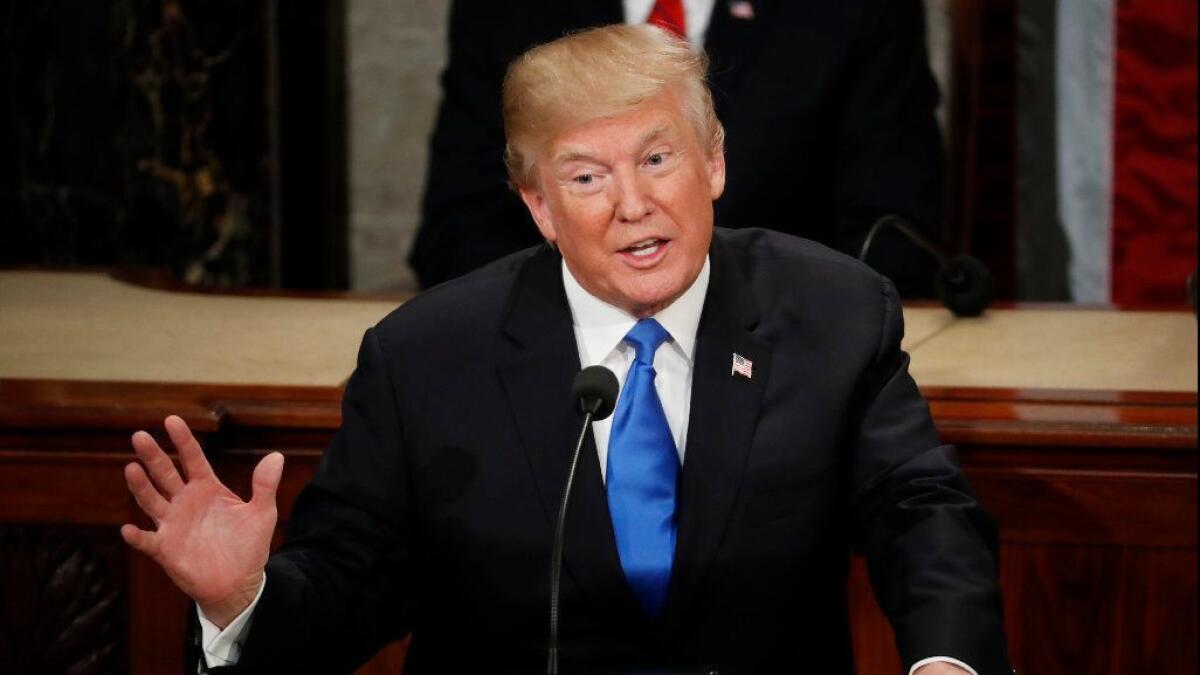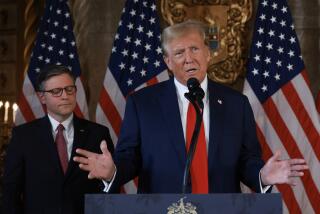Trump says State of the Union speech will focus on unity amid divided government

Reporting from Washington — Rarely has the mere scheduling of a State of the Union address shed so much light on the state of the nation, and specifically the relations among the leaders of its government.
President Trump is to deliver the annual address to a joint session of Congress Tuesday night, a week later than initially planned. For the first time, he faces a newly empowered Democratic opposition that is deeply opposed to his hard-line immigration agenda, and primed to investigate his administration on a range of issues.
“It’s going to be a speech that’s going to cover a lot of territory, but part of it is going to be unity,” Trump told reporters last week. Aides say he will highlight five issues: immigration, trade, infrastructure, prescription drug pricing and national security.
The speech was delayed amid the longest government shutdown in American history after House Speaker Nancy Pelosi rescinded the invitation and agreed to reschedule only when the shuttered agencies were funded and reopened — a blunt reminder to Trump that he now shares power with her and other House Democrats who won a majority in November.
Heightening interest in Trump’s televised address at his midterm, it will be Pelosi looking over his shoulder from the House dais, not a compliant Republican.
Their truce could well be short-lived. The funding agreement that allowed the president to proceed with the address is only temporary. A Feb. 15 deadline looms to pass another government funding bill, amid little indication that he and Democrats are any closer to agreement on the issue that divides them: billions for his border wall.
Trump has threatened to call a national emergency to build the wall, even hinting that he might do so on Tuesday. But such use of executive authority to circumvent Congress’ power of the purse has sparked warnings from Republicans as well as Democrats of legislative or legal action to counter him.
In a preview of the address under the condition of anonymity, a senior administration official said the theme would be “choosing greatness” and that Trump would “encourage Congress to reject the politics of resistance and retribution, and instead adopt a spirit of cooperation and compromise.”
“Together we can break decades of political stalemate,” Trump plans to say, according to an excerpt. “We can bridge old divisions, heal old wounds, build new coalitions, forge new solutions, and unlock the extraordinary promise of America’s future. The decision is ours to make.”
The lofty tone echoes language Trump used in his previous two addresses to Congress, rare occasions when the disruptive president has generally followed tradition. Yet it belies Trump’s usual, public comments and tweets that have helped make him one of the most polarizing presidents in modern history.
Despite raw feelings on Capitol Hill and prospects that Trump’s agenda will be hobbled by investigations and 2020 electoral concerns over the next two years, the speech allows Trump an opportunity to lay out his policy agenda and make the case directly to the American people in prime time.
Immigration will probably be the most prominent theme, given Trump’s belief that keeping his campaign promise to build the wall is central to his reelection prospects. Two years ago, just after taking office, he said in his address to Congress that he would soon be building “a great, great wall.”
He is no longer demanding 2,000 miles of concrete or bricks across the entire southern border and is requesting billions of dollars from the Treasury rather than Mexico. Democrats have resisted funding what Pelosi calls an “immoral” wall, instead proposing spending money on drones, additional border agents and other law-enforcement measures.
Trump’s trade agenda poses a more complex case to make. Despite opposition from many Republican allies, and pain to his farm supporters, he has opened a trade war with China that he insists is close to yielding results in concessions from Beijing. He has renegotiated the North American Free Trade Agreement with Canada and Mexico; though the new deal is far from the radical overhaul Trump promised, Congress’ approval is uncertain, given that trade always splits both parties.
The president will also call for an infrastructure plan — for the third year in a row. In 2017, he asked Congress for $200 billion toward $1 trillion in combined private and public investment. In 2018, he increased his goal to $1.5 trillion.
The issue from the start has offered Trump his best chance for a bipartisan achievement. Yet his administration has not devoted sustained attention to a spending initiative unpopular with many Republicans, and some Democrats are skeptical of the administration’s commitment to the government’s contribution.
Trump could also seek bipartisan support on part of his healthcare agenda, after his failed effort to repeal the Affordable Care Act, by shifting his efforts to reducing prescription drug prices.
Since taking office, Trump has repeatedly promised to rein in prices, issuing a blueprint last year that laid out proposals to change the way that Medicare, in particular, purchases drugs and regulates prescription drug plans.
The Department of Health and Human Services has moved to implement some of those ideas. Last week, officials unveiled a proposal to crack down on secretive drug rebates frequently negotiated between drug manufacturers and drug plans.
But the administration has shown limited interest in more robust measures, favored by many Democrats, to give Medicare direct authority to negotiate or regulate most drug prices. And drug makers continue to aggressively raise prices; the costs of more than 250 prescription drugs increased this year, according to a Reuters analysis.
In the national security portion of his speech, Trump will cover a variety of goals and policies. The administration has been heavily invested in an effort to oust Venezuelan President Nicolas Maduro, leading an international effort to recognize opposition leader Juan Guaidó. The standoff is one of several that puts Trump in opposition to Russia, despite his overtures to President Vladimir Putin.
Trump also could announce the date and place for his second summit with North Korean leader Kim Jong Un. He has already said it will take place in late February, and reports have suggested Vietnam as the venue.
The president has been criticized for seeking another meeting despite a lack of concessions from Kim. North Korea continues to advance its nuclear program, despite Trump’s declaration after last year’s summit that the nation was “no longer a nuclear threat.” His intelligence leaders testified in Congress last week that North Korea is unlikely to give up its nuclear weapons or missiles.
Trump is also at odds with his intelligence chiefs over their assessment of the threat from Islamic State. Trump has declared the group defeated as he’s made the case for withdrawing troops from Syria, while his intelligence advisors say the group is rebuilding itself in Iraq and Syria, with thousands of fighters still under its command.
Times staff writer Noam N. Levey contributed to this report.
Follow the latest news of the Trump administration on Essential Washington »
More to Read
Get the L.A. Times Politics newsletter
Deeply reported insights into legislation, politics and policy from Sacramento, Washington and beyond. In your inbox three times per week.
You may occasionally receive promotional content from the Los Angeles Times.











